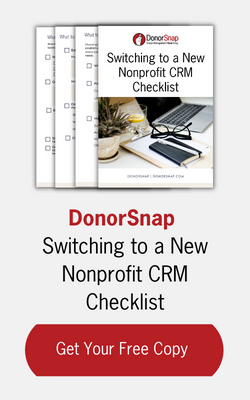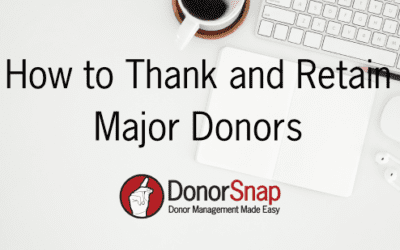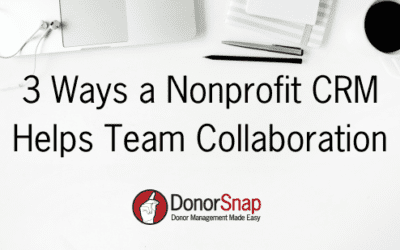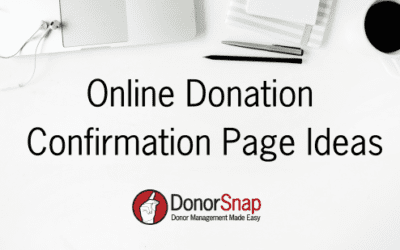What is a LYBUNT Report?
LYBUNT is an acronym for Last Year gave But Unfortunately Not This. LYBUNT reports are used by nonprofits to find lapsed donors. Lapsed Donors are donors who gave within a specific time period but not in the following time period. With the average donor retention rate in 2020 was 43.6%, it is important for nonprofits to catch lapsed donors early on and re-engage them.
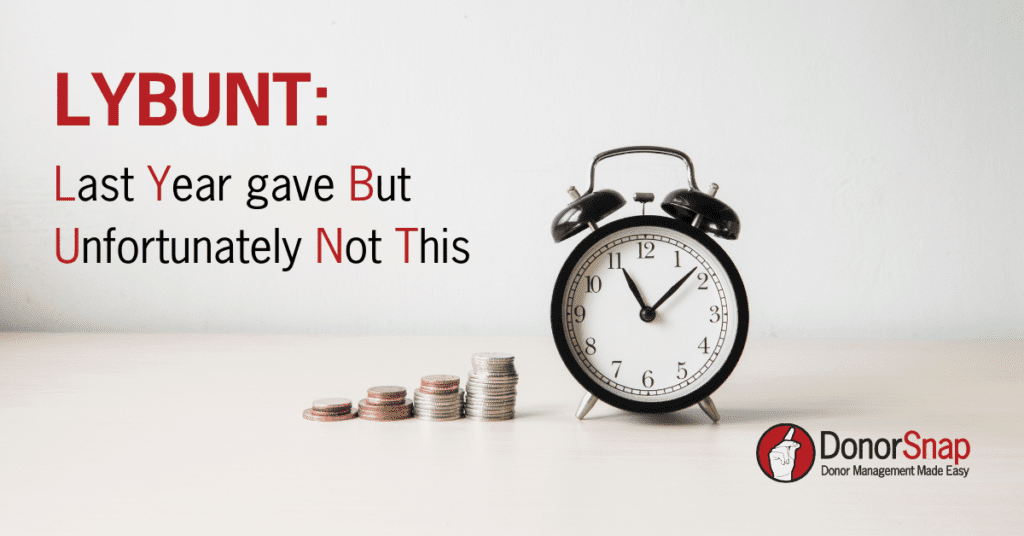
A LYBUNT report will give you any donor within a selected period of time, who did not give in the expected following period of time.
For example, if a donor gave $100 in January of 2020, but not January of 2021, they would show up on a LYBUNT report if you run it for the month of January 2021. Additionally, if someone gave $2,000 in 2019 but not in 2020, they would show up if you pulled a yearly LYBUNT at the end of FY2020.
You can easily generate a LYBUNT report in DonorSnap, under the reports tab>fund development analysis>LYBUNT. Learn more about creating LYBUNT reports in DonorSnap here.
What is a SYBUNT Report?
Similarly, you may want to run a campaign that casts a wider net. This is where you would want to use a SYBUNT report.
SYBUNT stands for Some Year gave But Unfortunately Not This.

SYBUNT Reports will allow you to see who has given in a number of given periods, but not the current one. You may want to use a SYBUT report to see who gave at any point in the last three years, but not in the current year.
You can easily get a SYBUNT Report directly out of DonorSnap’s LYBUNT report by adjusting the donation date range.
Why are LYBUNT and SYBUNT Reports Important?
LYBUNT and SYBUNT reports are important to nonprofits because they allow you to look for low-hanging fruit. Nonprofit organizations have an average retention rate of 43.6%. In order to meet or exceed this retention rate, it is important to nurture the donors you have.
Also, it costs more money to gain a new supporter than to retain a current one. According to amplifi, it can cost your nonprofit 50 to 100 percent more to acquire a new donor than you will receive from their first gift.
You use LYBUNT or SYBUNT reports to run lapsed donor campaigns. Lapsed donor campaigns are highly effective in collecting donations. The benefit of reaching out to someone who has given before, is you have personalized information on them. Also, people who have given to your organization once are likely to give again.
People who have given to your organization once, have already learned about your organization and decided it was worthy of a donation. Because of this, they are further along in your donation funnel. Although they missed a donation, they are already familiar with your organization. Therefore, you need less to re-engage them.
How to use LYBUNT Reports to Run Lapsed Donor Campaigns
1. Analyze Your Data
The first step in a re-engagement campaign is to look at your data and try to figure out the reason for the lapsed donation. It is important to think critically when you look at your lapsed donor data.
Here are some things to ask yourself as you analyze your lapsed donor data:
- Did the donor give to a capital campaign but is not an annual member? If this is the case you can segment out one-time donors to capital campaigns and run a campaign that stresses the importance of annual unrestricted giving.
- Did the donor move? Changes in demographic location may be the reason the donor stopped giving. But that doesn’t mean they have to stop supporting your organization. Think about ways to tell them they can continue to support you from afar. Also, it is possible you do not have their new address. Luckily, DonorSnap offers a free NCOA cleaning every year so every address in your database will be up to date.
- Did the donation amount gradually decrease over time? Perhaps this person has been under economic hardship and is unable to give. In this instance, you should still be reaching out to them with updates on your organization. Even if they can’t give, staying engaged with your organization is important. You could also share the importance of small gifts.
- Do you notice any trends around changes you made in your organization? Check to see if your communication schedule changed, or if you hosted particular events. Look and see what your organization did or didn’t do over certain time periods. Then look at your lapsed donor data and see if there is any correlation.
- Does it look like they just forgot to give? This group is the easiest to re-engage. Try encouraging them to sign up for a recurring giving program. Highlight the benefits of it saving them time, and offering secured support for your organization.
If you have practiced good data management you should be able to get all of this information from your database easily using built-in reporting tools.
2. Segment your lapsed donor groups
Now that you have analyzed your data you can segment your lapsed donors. You are going to want to do this for a number of reasons. First, different groups will need different methods of communication. Also, depending on the cause of the lapsed donation you are going to be conveying different messages. In fact, some lapsed donors shouldn’t be asked for money. So it is important to think about how to group your segments.
Segment by $ amount on LYBUNTS and SYBUNTS
Donors who give < $1,000 a year may give at any time of the year. It could be difficult to predict when they have actually become lapsed in a one year period. For this reason, it is probably not necessary to pull a monthly LYBUNT for donors who give less than $1k a year. A yearly LYBUNT might be better suited for donors of smaller gifts.
However, donors of major gifts may be on a more rigid giving schedule. It may make sense to monthly or quarterly run LYBUNTS on major gifts so you and your team are aware of where you stand.
This is helpful because if a major gift has gone astray for months in your organization, you and your development team may need to plan a personalized outreach. This may be a little more touchy than a simple email, lapsed donor campaign.
Segment by the method of communication
Depending on your campaign you should decide if you will use email, direct mail, phone calls, or a combination of them all. You can also decide which campaigns might be best left to automation. If you determine one group of lapsed donors is just a case of they forgot to give, then an automation campaign is probably a sufficient solution.
Hint: In DonorSnap you can set up lapsed donor campaigns to run automatically using the Automated Task Manager. This is a great way to engage recently lapsed donors without even thinking about it.
3. Craft your message
If you want successful lapsed donor campaigns you need to carefully craft your message. Remember, lapsed donor campaigns do not always have to ask for money. In fact, some segments of lapsed donors may need re-engagement first. So think about how you can communicate what your organization is doing and how their support would help in ways that will resonate with the individual segments.
If you are having trouble thinking about the messages, refer back to the questions you asked when you were analyzing your data.
Summary
LYBUNT and SYBUNT reports allow you to see donors who gave in one time period, but not another. You should use LYBUNT and SYBUNT reports to run lapsed donor campaigns. Lapsed donor campaigns are highly effective because people who gave to your organization have previously been engaged and are likely to give again.
Use the following steps to run a lapsed donor campaign after you run your LYBUNT or SYBUNT report:
- Analyze your data
- Segment your lapsed donor groups
- Sort by the $ amount of your lapsed donor campaign
- Segment by your method of communication
- Craft your message
Be sure to regularly look at your LYBUNT and SYBUNT reports and run lapsed donor campaigns often. This can be a highly effective strategy to re-engage lapsed donors and drive more repeat gifts.

